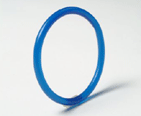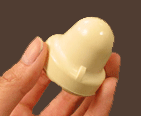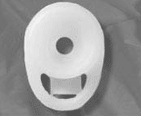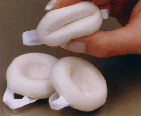A vaginal contraceptive ring is one of the most modern ways of contraception for women. This elastic ring is of 54 millimeters diameter and is to be placed into the vagina. Like a birth control pill , a vaginal contraceptive ring contains small amounts of female hormones –estrogen and progesterone. These hormones are slowly released into a woman’s body and protects against pregnancy.
A vaginal contraceptive ring should be inserted into vagina, close to the cervix of uterus, and should be left there for three weeks. Unlike with a birth control pill a woman using it does not have to worry about the ring every day, since when inserted into the vagina a vaginal contraceptive ring acts for three weeks. A woman should take the ring out after three weeks and then menstrual period occurs due to a sudden decrease of female hormones in the body — just like during a normal period. Another vaginal contraceptive ring should be inserted into vagina after one week.
How does contraceptive ring work?
 You are probably now wondering how the ring works in birth control. Its action is due to female hormones – estrogen and progesterone — that are absorbed into a female bloodstream through vaginal walls. These two hormones suppress ovulation, meaning that no egg is produced in the ovary. They also thicken the mucus on the cervix, so that it is complicated for the sperm to enter the uterus. The last action of the combination of estrogen and progesterone is the change of uterine lining in such a way that it is almost impossible for a fertilized egg to implant. Bear in mind that although a vaginal contraceptive ring is efficient in birth control, it does not protect against any of sexually transmitted diseases. Therefore a condom must be used during sexual intercourse for protection against sexually transmitted diseases.
You are probably now wondering how the ring works in birth control. Its action is due to female hormones – estrogen and progesterone — that are absorbed into a female bloodstream through vaginal walls. These two hormones suppress ovulation, meaning that no egg is produced in the ovary. They also thicken the mucus on the cervix, so that it is complicated for the sperm to enter the uterus. The last action of the combination of estrogen and progesterone is the change of uterine lining in such a way that it is almost impossible for a fertilized egg to implant. Bear in mind that although a vaginal contraceptive ring is efficient in birth control, it does not protect against any of sexually transmitted diseases. Therefore a condom must be used during sexual intercourse for protection against sexually transmitted diseases.
If you decide to use a vaginal contraceptive ring for birth control, you should consult your health care specialist in order to find out when you should start using it. Women who have not used any hormonal pill of birth control before should insert the ring between the first five days of their menstrual period. When inserted for the first time a vaginal contraceptive ring is ineffective for the first week. Therefore women should use additional means of contraception, such as male condoms or spermicide, for the first seven days. If a woman switches from one hormonal form of birth control to a vaginal contraceptive ring, the ring should be efficient as soon as a woman starts using it. There are certain modulations on when to start using a contraceptive ring after abortion or miscarriage, and hence a woman should contact her health care provider to find out the exact information. Another question that a health care specialist should answer is breast-feeding and when a woman may start using a vaginal contraceptive ring then.
How to use vaginal contraceptive ring?
A flexible vaginal contraceptive ring is very easy to use and place into the vagina. With your hands washed and dry you may remove the ring from its foil packet. You are recommended to not throw the packet away since you are going to need it when the ring is removed. You should choose the most comfortable position for you for insertion – either lying down or standing with one leg up. Probably choosing the same position that you use for insertion of tampons might be helpful. Then you should insert the ring into vagina as deeply as possible. A vaginal contraceptive ring should be left for three weeks and replaced on the same day of the week and time. You should insert another ring after one week break.
When placed properly in the vagina a vaginal contraceptive ring should not come out accidentally. However, during sexual intercourse, while taking the tampon out or due to a strain with bowel movements the ring may come out. If it does, a woman should rinse it with lukewarm water and place the ring into vagina as soon as possible. In case a vaginal contraceptive ring has been out of the vagina for three hours or more, it might not be efficient in birth control for the first week. Therefore additional methods of contraception should be used within that period of time.
 A cervical cap should be inserted into the vagina a few hours before having sex. Most women like it because they do not have to care about other
A cervical cap should be inserted into the vagina a few hours before having sex. Most women like it because they do not have to care about other  There are a lot of benefits of
There are a lot of benefits of A cervical cap is easy to use, and women, who use this device, are happy with the benefits they gain, but there are still a few side effects and risks associated with the use of this barrier contraceptive method.
A cervical cap is easy to use, and women, who use this device, are happy with the benefits they gain, but there are still a few side effects and risks associated with the use of this barrier contraceptive method. This birth control device has a round shape and smooth edges. Unlike other barrier contraceptive methods, Lea’s shield is provided in one size. Therefore, there is no need to be fitted for every woman’s anatomy like with diaphragms. It also has a valve in center, which does not allow sperm to enter the cervix but lets the cervical mucus through.
This birth control device has a round shape and smooth edges. Unlike other barrier contraceptive methods, Lea’s shield is provided in one size. Therefore, there is no need to be fitted for every woman’s anatomy like with diaphragms. It also has a valve in center, which does not allow sperm to enter the cervix but lets the cervical mucus through.  The contraceptive sponge is a soft sponge that contains
The contraceptive sponge is a soft sponge that contains